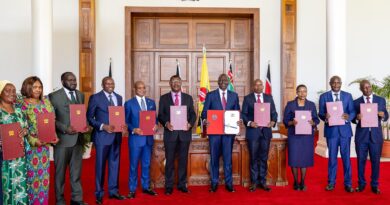KALRO Climate Smart Agriculture Technologies for Dairy Value Chain
Press Release
Kenya Agricultural and Livestock Research Organization has developed dairy technologies, innovations and management practices (TIMPs) through research to address some challenges in the value chain.
These TIMPs include assisted reproduction technologies (ART) in dairy breeding, disease tolerant basal and supplementary forages, forage conservation technologies, feed rations for maintenance and milk production, fortification of feeds, milk value addition and manure management.
The training currently being undertaken in Thika by KALRO scientists will provide the trainer of trainers drawn from various counties with knowledge and skills on dairy cattle management focusing on breeding management, efficient feeds production, budgeting and utilization, milk handling and processing. Other areas include dairy business management, marketing and social and environmental concerns in dairy farming and trade.
The dairy sub-sector in Kenya is considered the most developed in Sub-Saharan Africa. At the national level, this sector contributes 3.5% of the total GDP. The current milk output is estimated at 5.2 billion litres per annum out of which 60% is from grade dairy cattle and their crosses while the remaining 40% comes from zebu, camel and goats. The national dairy herd is estimated at 3.3 million heads majority of which are grade cattle. Smallholder farmers account for about 2.5 million dairy cows producing over 80% of total national milk output. Of the total milk produced, about 60% is marketed through traders, cooperatives, hotels and kiosks. An estimated 84% of the milk produced is sold in raw form. It is further estimated that, in the entire milk commodity chain, from producers (farmers) to milk hawkers, nearly one million households and business are involved.
Today, informal milk sector accounts for more than 70% of the 40,000 jobs in dairy marketing alone and further directly supports over 350,000 others in formal employment.
1
Considering that there are nearly one million smallholder farmers, for whom dairy is a family business, it is likely that more than two million people derive livelihood from the dairy sector. However, despite the plausible performance, Kenya’s dairy industry is bedeviled by several challenges, of which inadequate feed, prevalence of diseases (especially tick-borne), availability of quality replacement stock, low adoption of technologies, and high cost of farm inputs (including fodder/pasture seeds) and low milk value addition among dairy producers, are the most critical.
Dairy TIMPS are part of activities under Kenya Climate Smart Agriculture Project (KSCAP), funded by the World Bank. KALRO is expected provide technologies and promote and facilitate adoption of agricultural technologies, innovations, management and practices (TIMPS) to achieve the CSA Climate smart technologies (CSA) triple-wins of increased productivity, enhanced resilience, and reduced greenhouse emissions.
The direct beneficiaries of the (KSCAP), project are estimated at about 521,500 households of smallholder farmers, agro-pastoralists, and pastoralists. Approximately 163,350 households organized in about 4,950 Common Interest Groups (CIGs) and 18,150 households in 1,100 Vulnerable and Marginalized Groups (VMGs)27 will benefit from community CSA micro projects.
Eliud Kireger PhD. OGW
DIRECTOR GENERAL- KALRO

